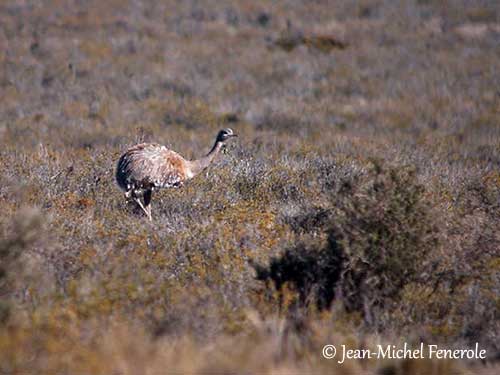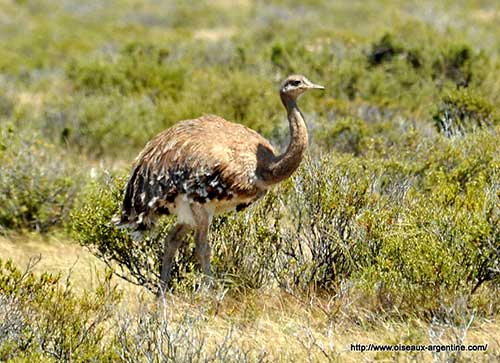
Fr: Nandou de Darwin
Ang: Lesser Rhea
All: Darwinnandu
Esp: Ñandú petiso
Ita: Nandù minore
Nd: Darwins Nandoe
Sd: mindre nandu
Photographers:
John Anderson
John Anderson Photo Galleries
Jean Michel Fenerole
Photos d’Oiseaux du monde
Philippe & Aline Wolfer
GALERIE
Text by Nicole Bouglouan
Sources:
HANDBOOK OF THE BIRDS OF THE WORLD vol 1 by Josep del Hoyo-Andrew Elliot-Jordi Sargatal - Lynx Edicions - ISBN: 8487334105
Birdlife International (Puna Rhea)
Animal Diversity Web (University of Michigan Museum of Zoology)
Arthur Grosset's Birds (Arthur Grosset)
Restoring a rare bird species to Chilean Patagonia
Neighboring Species – American Museum of Natural History
Wikipedia, the free encyclopaedia
Lesser Rhea
Rhea pennata
Rheiformes Order – Rheidae Family
INTRODUCTION:
The Lesser Rhea is smaller than the Greater Rhea - Rhea americana, and both species form the family Rheidae.
The Lesser Rhea shares the range with three subspecies, from the Andean Plateau (Altiplano) through Argentina, Bolivia, Chile and Peru. All races frequent grasslands, brushlands and marshlands, usually at mid to high elevation.
The two northern subspecies, R.p. tarapacensis and R.p. garleppi are considered by the IUCN a separate species named the Puna Rhea with two subspecies. Both were described by Charles Chubb, an English ornithologist, in 1913.
The Lesser Rhea, R.p. pennata, also named Darwin’s Rhea, was first described by Charles Darwin in 1834.
The Lesser Rhea feeds primarily on plant matter, but lizards and insects are occasionally taken. The rheas live in groups outside the breeding season.
Like the Greater Rhea, the male alone performs all the nesting duties.
The Lesser Rhea is described as “uncommon” and the population is suspected to be declining. The birds are affected by hunting and egg-collection, but currently, the species is not globally threatened.

DESCRIPTION OF THE BIRD:
Biometrics:
Height: 90-100 cm
Length: 92-100 cm
Weight: 15-28,5 kg
The Lesser Rhea is very similar to the Ostrich – Struthio camelus but it is much smaller. Despite having larger wings, it is flightless too. There is a strong claw at the end of each wing, often used in defence.
The plumage is brownish with white flecking overall. The feathers are smooth and soft.
The male has buffish-brown head, neck and upperparts. Back and wings feathers are tipped white.
The underparts are whitish. Lower throat and foreneck are browner. Thighs and top of tarsi are feathered on the front.
The brownish bill is small.
The eyes are dark brown.
Legs and feet are greyish to dull yellowish. The long tarsi (28-32 cm) have 16-18 horizontal plates on the front. The feet have three toes with sharp claws used as weapons.
The female is usually duller than the male, with less, smaller white spots on the back.
The juvenile is browner and the white spotting is absent. It gains the full adult plumage at 3-4 years old.
SUBSPECIES AND RANGE:
The Lesser Rhea has three subspecies.
R.p. pennata (described above) is found in S Chile and WC to S Argentina, in the Patagonian steppes of S Argentina and Magellanic Chile. It is also named Darwin’s Rhea. It has been introduced to N Tierra del Fuego.
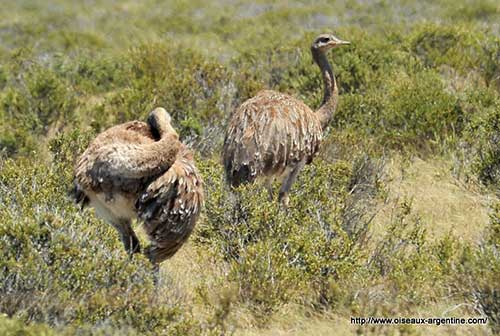
R.p. garleppi occurs in S Peru, through W Bolivia to NW Argentina. It has less grey head and neck and more grey-brown upper mantle than R.p. tarapacensis.
R.p. tarapacensis is found in N Chile. This race has greyish head and neck and the upperparts are rufous-brown with conspicuous greyish tinge.
Both garleppi and tarapacensis are sometimes classified as a separate species named Puna Rhea. Genetic studies reveal that they are closely related to the Greater Rhea - Rhea americana.
They differ from R. pennata in having only 8-10 horizontal plates on the front of the shorter tarsi. The upperparts are browner and show more extensive white spotting near the wing tips.
However, the plumage may vary with the age and during the breeding season.
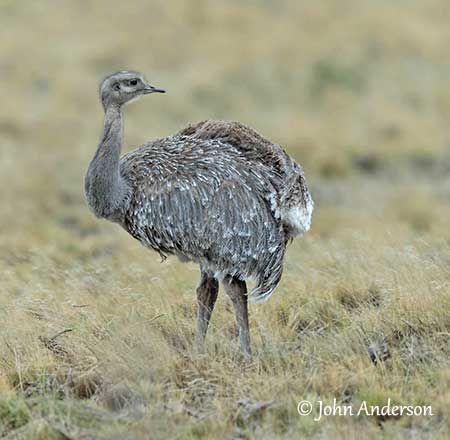
HABITAT:
The Lesser Rhea lives in the open plains of South America, usually in open land. All subspecies frequent grasslands, brushlands and marshlands.
The nominate race is mainly found from sea-level to 2,000 metres of elevation. In NW Patagonia, it prefers to breed in wet meadows areas rather than in steppes.
The two other races are mainly found in desert salt puna, upland bogs and heather moors on the Andean Plateau, up to 3,500/4,000 metres. In the E part of the range, they are usually around 2,000 metres, and as low as 1,200 metres in La Rioja in Argentina.
CALLS AND SONGS: SOUNDS BY XENO-CANTO
The Lesser Rhea gives a deep, low, resounding sound, mainly produced by the male during the courtship displays. This sound resembles the roar of a large mammal and can be heard at great distances.
Outside the breeding season, we can hear hoarse alarm calls and snorts during defence and threat displays.
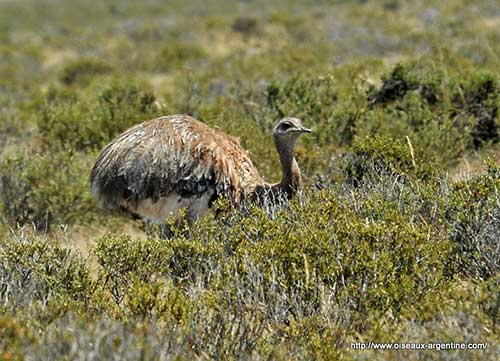
BEHAVIOUR IN THE WILD:
The Lesser Rhea is omnivorous, but it feeds primarily on plant matter including roots, fruits, seeds and leaves from a large variety of plants. However, insects (beetles and grasshoppers), lizards and carrion are also part of the diet. It also ingests pebbles. It does not need to drink water frequently, as the plant matter diet provides the bird sufficient liquid requirements.
The Lesser Rhea often forages with other species, including herbivorous mammals, and even cattle and sheep.
They can find the food without moving around because their habitats provide them sufficient food resources all year round.
The Lesser Rhea lives in mixed groups of all ages and both sexes, travelling in flocks of 5 to 30 individuals.
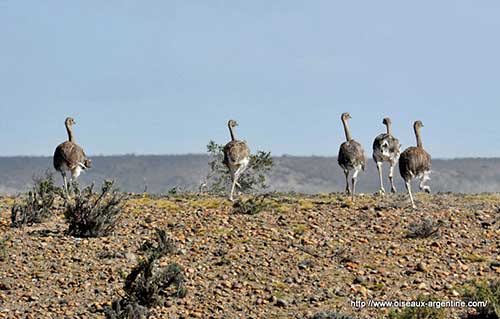
But during the breeding season, the females leave the groups while the males become territorial.
The males fight to establish their territories, and then, they try to attract females by running towards them with spread wings. When several females (2 to 12) are attracted into the territory, the male performs courtship displays. It produces various booming calls and runs around them while shaking the wings.
Following the copulation, the male leads the group of females to the prepared nest where they lay their eggs one after another. They return to the nest 2-3 days later to lay more eggs. Then, they leave to mate with another male and lay their eggs in another nest. The male performs alone all the nesting duties.
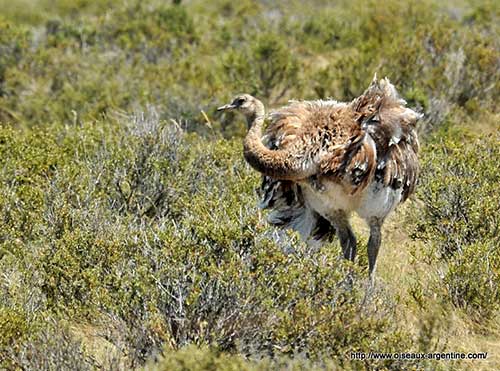
The Lesser Rhea is sedentary, with only some movements of the S populations into uplands for breeding.
It is flightless, but it is a strong swimmer able to cross a river. While running, it can reach speeds of 60 km/h. It also runs in zigzag pattern to confuse predators, or turns abruptly to change of direction.
While running, the neck is horizontal and the wings are folded, to pass easily through the bushes.
REPRODUCTION OF THIS SPECIES:
The breeding season takes place between September and January in the northern part of the range, from July in Río Negro in Argentina, and November in extreme south.
The nest is built by the male, a shallow scrape in the ground with a lining of grass, leaves and twigs. It is built in a hidden location.
The different females lay their eggs, usually 10-30 eggs per nest, sometimes more. They are yellowish/olive green but they usually fade to buff.
The male incubates alone during 30-44 days, usually 40 days. At hatching, the downy chicks are pale grey-brown on head and neck, the throat is whiter whereas crown and hindneck are darker.
On the upperparts, there are three conspicuous dark grey-brown stripes, separated by white stripes. The underparts are whitish with grey-brown stripes on breast sides, flanks and front of thighs, and a narrower darker stripe on the rear of the thighs.
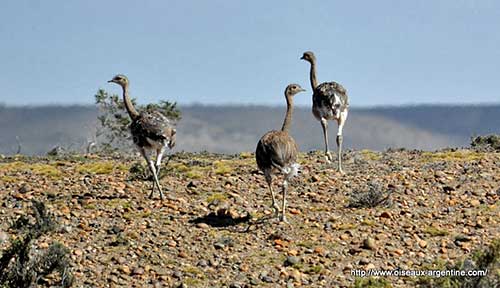
After a few days, the male leads them away from the nest, and they give some whistles to keep in touch. The male protects them under its wings if they are too hot, too cold or threatened. It is very protective.
The parental care may last up to six months, but the young rheas remain within the group until they can breed at 2-3 years old.
PROTECTION / THREATS / STATUS:
The rheas are hunted for their feathers, meat, eggs and other body parts. The habitat is destroyed by agriculture expansion.
The Puna Rhea (R. tarapacensis) and its subspecies R. garleppi are suspected to be declining due to habitat loss, hunting and egg collecting. It is currently listed as Near Threatened, but exact size and population trend are unknown, and it may be reclassified in the future.
The Lesser Rhea (R. pennata) is declining too, but it is not considered globally threatened. Introduced in Tierra del Fuego in 1936, this population is now well established. Captive breeding projects are on their way, both for conservation and commercial purposes.
The Lesser Rhea is currently evaluated as Least Concern.
